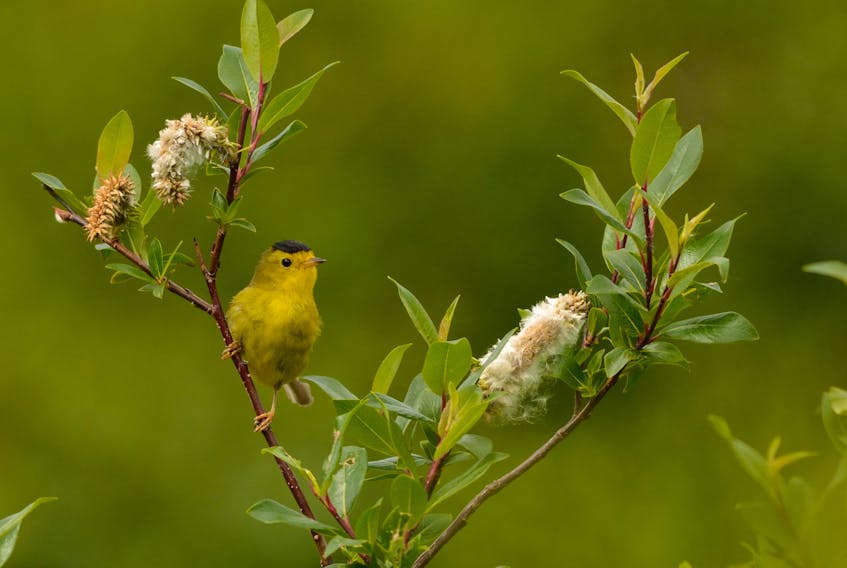From a bird’s eye view, it’s easy to spot why more boreal birds appear to be spending time in Torngat Mountains National Park.
The park area is dominated by arctic vegetation, but around isolated tree stands and in the valleys and fjords, you can find growing thickets — collections of bushes and shrubs more commonly found to the south, in the country’s boreal region.
These thickets offer a treat for native caribou, but also host the foraging and breeding of different birds.
The tall shrub — willow, alder, dwarf birch and other — in the Torngats has increased about six-fold since the 1980s, noted Parks Canada ecosystem scientist Darroch Whitaker, in a piece published by the journal The Canadian Field-Naturalist earlier this year. An ornithologist, Whitaker wrote about what he considers related observations, recorded over the course of nine summers of park fieldwork.
RELATED
The vegetation greenness trend in Canada and U.S. Alaska (1984-2012)
http://www.sciencedirect.com/science/article/pii/S0034425716300013
Expanded Range Limits of Boreal Birds in the Torngat Mountains (Subscription)
http://canadianfieldnaturalist.ca/index.php/cfn/article/view/1957
“My observations from 2008 to 2016 indicate that several northern boreal bird species are far more widespread and abundant in the central Torngat Mountains than has been reported previously,” he stated.
“Further, I found evidence that most of these species are occasionally or regularly breeding tens and hundreds of kilometres north and east of previously reported range limits.”
•••
At this point, the greening of the North has been established through Inuit knowledge, park reports and satellite imagery.
Jeffrey Masek and Junchang Ju at NASA’s Goddard Space Flight Center in Greenbelt, Maryland reviewed 87,000 images from Landsat satellites and determined about 30 per cent of northern North America —including Alaska and Canada — had become distinctly greener between 1984 and 2012, particularly with more shrub. Only about three per cent of the area showed less vegetation over the same period.
It was an “unmistakable trend,” according to NASA and the paper published in the spring of 2016 in Remote Sensing and Environment.
The report highlighted particularly significant changes in Quebec and northern Labrador.
Closer to home, a 2015 review by Parks Canada remote sensing specialist Justin Quirouette used multiple sources in determining shrub cover in Torngat Mountains National Park has “dramatically increased” over the last 30 years.
“Results … are consistent with earlier studies, existing paired ground and aerial photographs taken over time, and observations from local communities,” he stated.
•••
Any changes in park vegetation are multi-faceted, Whitaker said.
It is important to consider things like caribou numbers, fire events, invasive species and more, in addition to things like temperature and growing days.
However, he believes climate change is encouraging the vegetation North and supporting the migratory birds, with species including, but are not limited to: spotted sandpiper, American robin, gray-cheeked thrush, yellow-rumped warbler, blackpoll warbler, Wilson’s warbler, northern waterthrush and fox sparrow.
As for bird activity, there are not as many historical records, or as many bird atlas or citizen science projects in the North as in southern Canada, he told The Telegram, in an interview Friday.
So he gathered up studies available from ornithologists and naturalists who had travelled the area and recorded findings within the last century.
While the studies are less common than in the south, it is unlikely what he has recorded would have been missed in this past work, he said.
The birds are not necessarily new to the area, as these past studies indicate, but they now appear to be in higher numbers and reaching further.
“For these birds, there’s a lot of young produced every year and they’ll go out and try to find nesting territories and then, especially once they’ve nested in there, they’ll come back year after year and sometimes they’ll live up to 10 years. So it could be a lot of those local birds returning, plus it could be young birds that are nesting for the first time that have dispersed into the area,” he said.
“But there’s certainly a lot more now than there were historically.”
The observations on bird species in Labrador could be used as a starting point for further research, plus factored into ongoing discussions around the shifting ranges for North American birds in the context of climate change.









